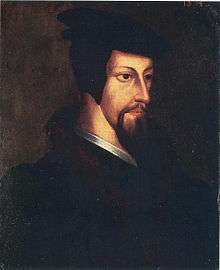French Wars of Religion
The French Wars of Religion were a prolonged period of war and popular unrest between Catholics and Huguenots (Reformed/Calvinist Protestants) in the Kingdom of France between 1562 and 1598. It is estimated that three million people perished in this period from violence, famine, or disease in what is considered the second deadliest religious war in European history (surpassed only by the Thirty Years' War, which took eight million lives).[1]
Much of the conflict took place during the long regency of Queen Catherine de' Medici, widow of Henry II of France, for her minor sons. It also involved a dynastic power struggle between powerful noble families in the line for succession to the French throne: the wealthy, ambitious, and fervently Catholic ducal House of Guise (a cadet branch of the House of Lorraine, who claimed descent from Charlemagne) and their ally Anne de Montmorency, Constable of France (i.e., commander in chief of the French armed forces) versus the less wealthy House of Condé (a branch of the House of Bourbon), princes of the blood in the line of succession to the throne who were sympathetic to Calvinism. Foreign allies provided financing and other assistance to both sides, with Habsburg Spain and the Duchy of Savoy supporting the Guises, and England supporting the Protestant side led by the Condés and by the Protestant Jeanne d'Albret, wife of Antoine de Bourbon, King of Navarre, and her son, Henry of Navarre.
Moderates, primarily associated with the French Valois monarchy and its advisers, tried to balance the situation and avoid open bloodshed. This group (pejoratively known as Politiques) put their hopes in the ability of a strong centralized government to maintain order and harmony. In contrast to the previous hardline policies of Henry II and his father Francis I, they began introducing gradual concessions to Huguenots. A most notable moderate, at least initially, was the queen mother, Catherine de' Medici. Catherine, however, later hardened her stance and, at the time of the St. Bartholomew's Day massacre in 1572, sided with the Guises. This pivotal historical event involved a complete breakdown of state control resulting in series of riots and massacres in which Catholic mobs killed between 5,000 and 30,000 Protestants over a period of weeks throughout the entire kingdom.
At the conclusion of the conflict in 1598, the Protestant Henry of Navarre, heir to the French throne, converted to Catholicism and was crowned Henry IV of France. He issued the Edict of Nantes, which granted Huguenots substantial rights and freedoms though this did not end Catholic hostility towards them or towards him, personally. The wars of religion threatened the authority of the monarchy, already fragile under the rule of Catherine's three sons and the last Valois kings: Francis II, Charles IX, and Henry III. This changed under the reign of their Bourbon successor Henry IV. The edict of Nantes was revoked later in 1685 with the Edict of Fontainebleau by Louis XIV of France. Henry IV's wise governance and selection of able administrators did leave a legacy of a strong centralized government, stability, and economic prosperity that has gained him the reputation as France's best and most beloved monarch, earning him the designation "Good King Henry".
Name and duration
Along with French Wars of Religion and Huguenot Wars, the wars have also been variously described as the "Eight Wars of Religion", or simply the "Wars of Religion" (only within France).
The exact number of wars and their respective dates are subject to continued debate by historians: some assert that the Edict of Nantes in 1598 concluded the wars, while the ensuing resurgence of rebellious activity leads some to believe the Peace of Alès in 1629 is the actual conclusion. However, the agreed upon beginning of the wars is the Massacre of Wassy in 1562, and the Edict of Nantes at least ended this series of conflicts. During this time, complex diplomatic negotiations and agreements of peace were followed by renewed conflict and power struggles.
Background
Introduction of Reformation ideas
The Renaissance in France
Humanism, which began much earlier in Italy, arrived in France in the early sixteenth century, coinciding with the beginning of the French Protestant Reformation. The Italian revival of art and classical learning interested Francis I, who established royal professorships in Paris, equipping more people with the knowledge necessary to understand ancient literature. Francis I, however, had no quarrel with the established religious order and did not support reformation. Indeed, Pope Leo X, through the Concordat of Bologna increased the king's control over the French church, granting him the power of nominating the clergy and levying taxes on church property. In France, unlike in Germany, the nobles also supported the policies and the status quo of their time.[2]
The emphasis of Renaissance Humanism on ad fontes, the return to the sources, had inevitably spread from the study and reconstruction of secular Greek and Latin texts, with a view to artistic and linguistic renewal, to the reading, study, and translation of the Church Fathers and finally the New Testament itself, with a view to religious renewal and reform.[3] Humanist scholars, who approached theology from a new critical and comparative perspective, argued that exegesis of Scripture must be based on an accurate understanding of the language(s) and grammar(s) used in writing the Greek scriptures (New Testament) and also, later, the Hebrew Scriptures (Old Testament), rather than relying exclusively on the Vulgate, a Latin translation of the Bible, as in the Medieval period.[4]
In 1495 the Venetian Aldus Manutius began using the newly invented printing press to produce small, inexpensive, pocket editions of Greek, Latin, and vernacular literature, making knowledge in all disciplines available for the first time to a wide public.[5]
Printing in mass editions (including cheap pamphlets and broadsides) allowed theological and religious ideas to be disseminated at an unprecedented pace. In 1519 John Froben, a humanist printer, published a collection of Luther's works. In one correspondence, he reported that 600 copies of such works were being shipped to France and Spain and were sold in Paris.[6]

The Meaux Circle was formed by a group of humanists including Jacques Lefèvre d’Étaples and Guillaume Briçonnet, bishop of Meaux, in the effort to reform preaching and religious life. The Meaux circle was joined by Vatable, a Hebraist,[7] and Guillaume Budé, the classicist and librarian to the king.[8] Lefèvre's works such as the Fivefold Psalter and his commentary on the Epistle to the Romans were humanist in approach. They put emphasis on the literal interpretation of Scripture and highlighted Christ. Lefèvre's approach to the Scriptures influenced Luther's methodology on biblical interpretation.[6] Luther would later use his works in developing his lectures[9] that contained ideas that would spark the greater part of the Reformation known as Lutheranism. William Farel also became part of the Meaux circle. He was the leading minister of Geneva who invited John Calvin to serve there.[10] They were later exiled out of Geneva because they opposed governmental intrusion upon church administration. But their eventual return to Switzerland was followed by major developments in the Reformation that would later grow into Calvinism. Marguerite, Queen of Navarre, the sister of King Francis I and mother of Jeanne d'Albret, also became part of the circle.
Corruption of the established religious system
Corruption among the clergy showed the need for reform and Lutheran ideas made impressions of such hope.[11] Criticisms from the population played a part in spreading anticlerical sentiments, such as the publication of the Heptameron by Marguerite, a collection of stories that depicted immorality among the clergy.[12] Furthermore, the reduction of salvation to a business scheme based on the 'good works for sale' system added to the injury. Under these circumstances salvation by grace through faith in Jesus was a pleasant alternative (although Luther did teach baptismal regeneration). Works such as Farel's translation of the Lord's Prayer, The True and Perfect Prayer, with Lutheran ideas became popular among the masses. It focused on the biblical basis of faith as a free gift of God, salvation by faith alone, and the importance of understanding in prayer. It also contained criticisms against the clergy of their neglect that hampered growth of true faith.[12]
Growth of Calvinism
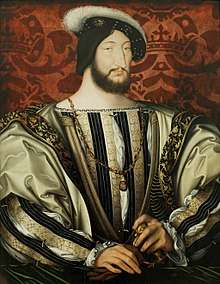
Protestant ideas were first introduced to France during the reign of Francis I of France (1515–1547) in the form of Lutheranism, the teachings of Martin Luther. Discussion and written works circulated in Paris unimpeded for more than a year. Although Francis firmly opposed Lutheranism as being heresy, the initial difficulty was in recognizing precisely what was heretical and what was not. Roman Catholic doctrine and the definitions of its orthodox beliefs were unclear.[13] Francis tried to steer a middle course in the developing religious schism in France.[14] Despite this, in January 1535, Catholic authorities decided that those classified as "Lutherans" were actually Zwinglians (also heretical), followers of Huldrych Zwingli.[15] Calvinism, another form of Protestant religion, was soon introduced by John Calvin, a native of Noyon, Picardy,[16] who fled France in 1535 after the Affair of the Placards.[17]
The lower orders of society were where Protestantism made its impact in France.[18] However, Calvinism appears to have developed with large support from the nobility. It is believed to have started with Louis Bourbon, Prince of Condé, who while returning home to France from a military campaign, passed through Geneva, Switzerland and heard a sermon by a Calvinist preacher.[19] Later, Louis Bourbon would become a major figure among the Huguenots of France. In 1560, Jeanne d'Albret, Queen regnant of Navarre, converted to Calvinism, possibly due to the influence of Theodore de Beze.[19] She later married Antoine de Bourbon, and both she and their son Henry of Navarre would be leaders among the Huguenots.[20]
Affair of the Placards
Francis I of France had continued his policy of seeking a middle course in the religious rift in France until an incident called the Affair of the Placards.[14] The Affair of the Placards began in 1534, and started with protesters putting up anti-Catholic posters. The posters were not Lutheran but were Zwinglian or "Sacramentarian" in the extreme nature of the anti-Catholic content—specifically, the absolute rejection of the Catholic doctrine of "Real Presence."[14] Protestantism became identified as "a religion of rebels," helping the Catholic Church to more easily define Protestantism as heresy.
In the wake of the posters, the French monarchy took a harder stand against the protesters.[15][21] Francis had been severely criticized for his initial tolerance towards Protestants, and now was encouraged to repress them.[22] At the same time, Francis was working on a policy of alliance with the Ottoman Empire.[23] The ambassadors in the 1534 Ottoman embassy to France accompanied Francis to Paris. They attended the execution by burning at the stake of those caught for the Affair of the Placards, on 21 January 1535, in front of the Cathedral of Notre-Dame de Paris.[22]
John Calvin, a Frenchman, escaped from the persecution to Basle, Switzerland, where he published the Institutes of the Christian Religion in 1536.[14] In the same year, he visited Geneva, but was forced out for trying to reform the church. When he returned by invitation in 1541, he wrote the Ecclesiastical ordinances, the constitution for a Genevan church, which was passed by the council of Geneva.
Massacre of Mérindol


The Massacre of Mérindol took place in 1545 when Francis I of France ordered the punishment of the Waldensians of the village of Mérindol. The Waldensians had recently affiliated with the Reformed tradition of Protestantism, participating in "dissident religious activities". Historians estimate that Provençal troops killed hundreds to thousands of residents there and in the 22 to 28 nearby villages they destroyed. They captured hundreds of men and sent them to labor in the French galleys.[24]
Francis I died on 31 March 1547 and was succeeded to the throne by his son Henry II, who continued the harsh religious policy that his father had followed during the last years of his reign. Indeed, Henry II was even more severe against the Protestants than Francis I had been. Henry II sincerely believed that the Protestants were heretics. On 27 June 1551, Henry II issued the Edict of Châteaubriant, which sharply curtailed Protestant rights to worship, assemble, or even to discuss religion at work, in the fields, or over a meal.
In the 1550s, the establishment of the Geneva church provided leadership to the disorganized French Calvinist (Huguenot) church.[25] The French intensified the fight against heresy in the 1540s forcing Protestants to gather secretly to worship.[26] But by the middle of the century, the adherents to Protestantism in France had increased markedly in number and power, as the nobility in particular converted to Calvinism. Historians estimate that in the 1560s more than half of the nobility were Calvinist (or Huguenot), and 1,200–1,250 Calvinist churches had been established; by the outbreak of war in 1562, there were perhaps two million Calvinists in France. The conversion of the nobility constituted a substantial threat to the monarchy.[27] Calvinism proved attractive to people from across the social hierarchy and occupational divides, and it was highly regionalized, with no coherent pattern of geographical spread.
Rise of factionism
The accidental death of Henry II in 1559 created a political vacuum that encouraged the rise of factions, eager to grasp power. Francis II of France, at this point only 15 years old, was weak and lacked the qualities that allowed his predecessors to impose their will on the leading noblemen at court. However, the House of Guise, having an advantage in the King's wife, Mary, Queen of Scots, who was their niece, moved quickly to exploit the situation at the expense of their rivals, the House of Montmorency.[28][29] Within days of the King's accession, the English ambassador reported that "the house of Guise ruleth and doth all about the French King".[30]
The "Amboise conspiracy," or "Tumult of Amboise"
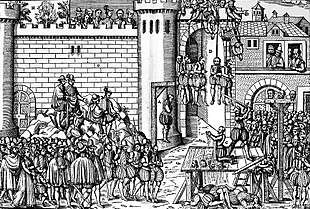
On 10 March 1560, a group of disaffected nobles (led by Jean du Barry, seigneur de la Renaudie) attempted to abduct the young Francis II and eliminate the Guise faction.[31] Their plans were discovered before they could succeed, and the government executed hundreds of suspected plotters.[32] The Guise brothers suspected Louis I de Bourbon, prince de Condé, of leading the plot.[31] He was arrested and due to be executed before being freed in the political chaos that marked the sudden death of Francis II, adding to the tensions of the period.[33] (In the polemics that followed, the term "Huguenot" for France's Protestants came into widespread usage.[34])
Iconoclasm and civic disturbances
The first instances of Protestant iconoclasm, the destruction of images and statues in Catholic churches, occurred in Rouen and La Rochelle in 1560. The following year, mobs carried out iconoclasm in more than 20 cities and towns; Catholic urban groups attacked Protestants in bloody reprisals in Sens, Cahors, Carcassonne, Tours and other cities.[35]
Death of Francis II
On 5 December 1560, Francis II died, and his mother Catherine de' Medici became regent for her second son, Charles IX.[36] Inexperienced and faced with the legacy of debt from the Habsburg–Valois conflict, Catherine felt that she had to steer the throne carefully between the powerful and conflicting interests that surrounded it, embodied by the powerful aristocrats who led essentially private armies. She was intent on preserving the independence of the throne.[37] She was prepared to deal favourably with the House of Bourbon in order to have a counterweight against the overmighty Guise, arranging a deal with Antoine of Navarre in which he would renounce the rights to the regency in return for the freedom of Condé and the position of lieutenant general of the kingdom.[38] Although she was a sincere Roman Catholic, she nominated a moderate chancellor, Michel de l'Hôpital, who urged a number of measures providing for civic peace so that a religious resolution could be sought by a sacred council.[39][40]
Colloquy of Poissy and the Edict of Saint-Germain
The Regent Queen-Mother Catherine de Medici had three courses of action open to her in solving the religious crisis in France. First she might revert to persecution of the Huguenots. This, however, had been tried and had failed—witness the fact that the Huguenots were now more numerous than they had ever been before.[41] Secondly, Catherine could win over the Huguenots. This though might lead directly to civil war.[41] Thirdly, Catherine might try to heal the religious division in the country by means of a national council or colloquy on the topic.[41] Catherine chose the third course to pursue. Thus, a national council of clergy gathered on the banks of the Seine River in the town of Poissy in July 1561. The council had been formed in 1560 during the Estates-General of Saint-Germain-en-Laye when the council of prelates accepted the crown's request to give Huguenots a hearing. The Protestants were represented by 12 ministers and 20 laymen, led by Théodore de Bèze. Neither group sought toleration of Protestants, but wanted to reach some form of concord for the basis of a new unity. The council debated the religious issue at Poissy all summer. Meanwhile, a meeting between Bèze and the Cardinal of Lorraine, of the House of Guise, seemed promising; both appeared ready to compromise on the form of worship. The King of Navarre and the Prince of Condé petitioned the Regent for the young King Charles IX—the Queen-Mother, Catherine de Medici for the free exercise of religion.[42] In July 1561, the Parliament passed and the Regent signed the July Edict which recognised Roman Catholicism as the state religion but forbade any and all "injuries or injustices" against the citizens of France on the basis of religion.[43] However, despite this measure, by the end of the Colloquy in Poissy in October 1561, it was clear that the divide between Catholic and Protestant ideas was already too wide.[44]
In early 1562, the regency government attempted to quell escalating disorder in the provinces, which had been encouraged by factional feuds at court, by instituting the Edict of Saint-Germain, also known as the Edict of January. The legislation made concessions to the Huguenots to dissuade them from rebelling. It allowed them to worship publicly outside of towns and privately inside them. On 1 March, however, a faction of the Guise family's retainers attacked a Calvinist service in Wassy-sur-Blaise in Champagne, massacring the worshippers and most of the residents of the town. The Huguenot Jean de la Fontaine described the events:
"The Protestants were engaged in prayer outside the walls, in conformity with the king's edict, when the Duke of Guise approached. Some of his suite insulted the worshippers, and from insults they proceeded to blows, and the Duke himself was accidentally wounded in the cheek. The sight of his blood enraged his followers, and a general massacre of the inhabitants of Vassy ensued."[45]
1562–1570
The "first" war (1562–1563)


The massacre of Vassy, on 1 March 1562, provoked open hostilities between the factions supporting the two religions.[46] A group of Protestant nobles, led by the prince of Condé and proclaiming that they were liberating the king and regent from "evil" councillors, organised a kind of protectorate over the Protestant churches. On 2 April 1562, Condé and his Protestant followers seized the city of Orléans.[47] Their example was soon followed by Protestant groups around France. Protestants seized and garrisoned the strategic towns of Angers, Blois, and Tours along the Loire River.[47] In the Rhône River valley, Protestants under François de Beaumont, baron des Adrets, attacked Valence; in this attack Guise's lieutenant was killed.[47] Later, the Protestants captured Lyon in 29–30 April[47][48] and proceeded to demolish all Catholic institutions in the city.[48]
Although the Huguenots had begun to mobilise for war before Vassy,[49] Condé used the massacre of Vassy as evidence that the July Edict of 1561 had been broken, lending further weight to his campaign. Hoping to turn over the city to Condé, the Huguenots of Toulouse seized the Hôtel de ville but were countered by angry Catholic mobs resulting in street battles and the killing of around 3,000—mostly Huguenots—during the 1562 Riots of Toulouse. Additionally, on 12 April 1562, and later in July, there were massacres of Huguenots at Sens and at Tours, respectively.[47] As conflicts continued and open hostilities broke out, the Crown revoked the Edict under pressure from the Guise faction.
The major engagements of the war occurred at Rouen, Dreux, and Orléans. At the Siege of Rouen (May–October 1562), the crown regained the city, but Antoine of Navarre died of his wounds.[50] In the Battle of Dreux (December 1562), Condé was captured by the Guises, and Montmorency, the governor general, was captured by those opposing the crown. In February 1563, at the Siege of Orléans, Francis, Duke of Guise, was shot and killed by the Huguenot Jean de Poltrot de Méré. As he was killed outside of direct combat, the Guise considered this an assassination on the orders of the duke's enemy, Admiral Coligny. The popular unrest caused by the assassination, coupled with the resistance by the city of Orléans to the siege, led Catherine de' Medici to mediate a truce, resulting in the Edict of Amboise on 19 March 1563.[51]
The "Armed Peace" (1563–1567) and the "second" war (1567–1568)

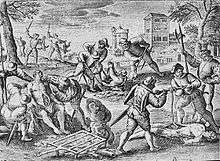
The Edict of Amboise was generally regarded as unsatisfactory by all concerned, and the Guise faction was particularly opposed to what they saw as dangerous concessions to heretics. The crown tried to re-unite the two factions in its efforts to re-capture Le Havre, which had been occupied by the English in 1562 as part of the Treaty of Hampton Court between its Huguenot leaders and Elizabeth I of England. That July, the French expelled the English. On 17 August 1563, Charles IX was declared of age at the Parlement of Rouen ending the regency of Catherine de Medici.[52] His mother continued to play a principal role in politics, and she joined her son on a Grand Tour of the kingdom between 1564 and 1566, designed to reinstate crown authority. During this time, Jeanne d'Albret met and held talks with Catherine at Mâcon and Nérac.
Reports of iconoclasm in Flanders led Charles IX to lend support to the Catholics there; French Huguenots feared a Catholic re-mobilisation against them. Philip II of Spain's reinforcement of the strategic corridor from Italy north along the Rhine added to these fears, and political discontent grew. After Protestant troops unsuccessfully tried to capture and take control of King Charles IX in the Surprise of Meaux, a number of cities, such as La Rochelle, declared themselves for the Huguenot cause. Protesters attacked and massacred Catholic laymen and clergy the following day in Nîmes, in what became known as the Michelade.
This provoked the Second War and its main military engagement, the Battle of Saint-Denis, where the crown's commander-in-chief and lieutenant general, the 74-year-old Anne de Montmorency, died. The war was brief, ending in another truce, the Peace of Longjumeau (March 1568),[53] which was a reiteration of the Peace of Amboise of 1563 and once again granted significant religious freedoms and privileges to Protestants.[53]
The "third" war (1568–1570)
In reaction to the Peace, Catholic confraternities and leagues sprang up across the country in defiance of the law throughout the summer of 1568. Huguenot leaders such as Condé and Coligny fled court in fear for their lives, many of their followers were murdered, and in September, the Edict of Saint-Maur revoked the freedom of Huguenots to worship. In November, William of Orange led an army into France to support his fellow Protestants, but, the army being poorly paid, he accepted the crown's offer of money and free passage to leave the country.
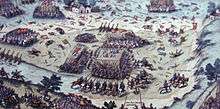
The Huguenots gathered a formidable army under the command of Condé, aided by forces from south-east France, led by Paul de Mouvans, and a contingent of fellow Protestant militias from Germany — including 14,000 mercenary reiters led by the Calvinist Duke of Zweibrücken.[54] After the Duke was killed in action, his troops remained under the employ of the Huguenots who had raised a loan from England against the security of the Jeanne d'Albret's crown jewels.[55] Much of the Huguenots' financing came from Queen Elizabeth of England, who was likely influenced in the matter by Sir Francis Walsingham.[54] The Catholics were commanded by the Duke d'Anjou—later King Henry III—and assisted by troops from Spain, the Papal States, and the Grand Duchy of Tuscany.[56]
The Protestant army laid siege to several cities in the Poitou and Saintonge regions (to protect La Rochelle), and then Angoulême and Cognac. At the Battle of Jarnac (16 March 1569), the prince of Condé was killed, forcing Admiral de Coligny to take command of the Protestant forces, nominally on behalf of Condé's 15-year-old son, Henry, and the 16-year-old Henry of Navarre, who were presented by Jeanne d'Albret as the legitimate leaders of the Huguenot cause against royal authority. The Battle of La Roche-l'Abeille was a nominal victory for the Huguenots, but they were unable to seize control of Poitiers and were soundly defeated at the Battle of Moncontour (30 October 1569). Coligny and his troops retreated to the south-west and regrouped with Gabriel, comte de Montgomery, and in spring of 1570, they pillaged Toulouse, cut a path through the south of France, and went up the Rhone valley up to La Charité-sur-Loire.[57] The staggering royal debt and Charles IX's desire to seek a peaceful solution[58] led to the Peace of Saint-Germain-en-Laye (8 August 1570), negotiated by Jeanne d'Albret, which once more allowed some concessions to the Huguenots.
St. Bartholomew's Day Massacre and after (1572–1573)
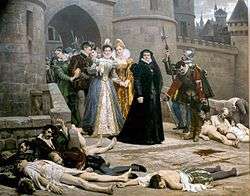
Anti-Protestant massacres of Huguenots at the hands of Catholic mobs continued, in cities such as Rouen, Orange, and Paris. Matters at Court were complicated as King Charles IX openly allied with the Huguenot leaders — especially Admiral Gaspard de Coligny. Meanwhile, the Queen Mother became increasingly fearful of the unchecked power wielded by Coligny and his supporters, especially as it became clear that Coligny was pursuing an alliance with England and the Dutch Protestant rebels.
Coligny, along with many other Calvinist nobles, arrived in Paris for the wedding of the Catholic princess Margaret of France to the Protestant prince Henry of Navarre on 18 August 1572. On 22 August, an assassin made a failed attempt on Coligny's life, shooting him in the street from a window. While historians have suggested Charles de Louvier, sieur de Maurevert, as the likely assailant, historians have never determined the source of the order to kill Coligny (it is improbable that the order came from Catherine).[59]
In preparation for her son's wedding, Jeanne d'Albret had arrived in Paris, where she went on daily shopping trips. She died there on 9 June 1572, and for centuries after her death, Huguenot writers accused Catherine de' Medici of poisoning her.

Amidst fears of Huguenot reprisals for the murder, the Duke of Guise and his supporters acted. In the early morning of 24 August, they killed Coligny in his lodgings with several of his men. Coligny's body was thrown from the window into the street, and was subsequently mutilated, castrated, dragged through the mud, thrown in the river, suspended on a gallows, and burned by the Parisian crowd.[60]
This assassination began the series of events known as the St. Bartholomew's Day massacre. For the next five days, the city erupted as Catholics massacred Calvinist men, women, and children and looted their houses.[61] King Charles IX announced that he had ordered the massacre to prevent a Huguenot coup and proclaimed a day of jubilee in celebration even as the killings continued.[62] Over the next few weeks, the disorder spread to more than a dozen cities across France. Historians estimate that 2,000 Huguenots were killed in Paris and thousands more in the provinces; in all, perhaps 10,000 people were killed.[63] Henry of Navarre and his cousin, the young Prince of Condé, managed to avoid death by agreeing to convert to Catholicism. Both repudiated their conversions after they escaped Paris.
The massacre provoked horror and outrage among Protestants throughout Europe, but both Philip II of Spain and Pope Gregory XIII, following the official version that a Huguenot coup had been thwarted, celebrated the outcome. In France, Huguenot opposition to the crown was seriously weakened by the deaths of many of the leaders. Many Huguenots emigrated to Protestant countries. Others reconverted to Catholicism for survival, and the remainder concentrated in a small number of cities where they formed a majority.
The "fourth" war (1572–1573)
The massacres provoked further military action, which included Catholic sieges of the cities of Sommières (by troops led by Henri I de Montmorency), Sancerre, and La Rochelle (by troops led by the duke of Anjou). The end of hostilities was brought on by the election (11–15 May 1573) of the Duke of Anjou to the throne of Poland and by the Edict of Boulogne (signed in July 1573), which severely curtailed many of the rights previously granted to French Protestants. Based on the terms of the treaty, all Huguenots were granted amnesty for their past actions and the freedom of belief. However, they were permitted the freedom to worship only within the three towns of La Rochelle, Montauban, and Nîmes, and even then only within their own residences. Protestant aristocrats with the right of high-justice were permitted to celebrate marriages and baptisms, but only before an assembly limited to ten persons outside of their family.[64]
1574–1584
Death of Charles IX and the "fifth" war (1574–1576)
In the absence of the duke of Anjou, disputes between Charles and his youngest brother, the duke of Alençon, led to many Huguenots congregating around Alençon for patronage and support. A failed coup at Saint-Germain (February 1574), allegedly aiming to release Condé and Navarre who had been held at court since St Bartholemew's, coincided with rather successful Huguenot uprisings in other parts of France such as Lower Normandy, Poitou, and the Rhône valley, which reinitiated hostilities.[65]
Three months after Henry of Anjou's coronation as King of Poland, his brother Charles IX died (May 1574) and his mother declared herself regent until his return. Henry secretly left Poland and returned via Venice to France, where he faced the defection of Montmorency-Damville, ex-commander in the Midi (November 1574). Despite having failed to have established his authority over the Midi, he was crowned King Henry III, at Rheims (February 1575), marrying Louise Vaudémont, a kinswoman of the Guise, the following day. By April, the crown was already seeking to negotiate,[66] and the escape of Alençon from court in September prompted the possibility of an overwhelming coalition of forces against the crown, as John Casimir of the Palatinate invaded Champagne. The crown hastily negotiated a truce of seven months with Alençon and promised Casimir's forces 500,000 livres to stay east of the Rhine,[67] but neither action secured a peace. By May 1576, the crown was forced to accept the terms of Alençon, and the Huguenots who supported him, in the Edict of Beaulieu, known as the Peace of Monsieur.
The Catholic League and the "sixth" war (1576–1577)

The Edict of Beaulieu granted many concessions to the Calvinists, but these were short-lived in the face of the Catholic League – which the ultra-Catholic, Henry I, Duke of Guise, had formed in opposition to it. The House of Guise had long been identified with the defense of the Roman Catholic Church and the Duke of Guise and his relations – the Duke of Mayenne, Duke of Aumale, Duke of Elboeuf, Duke of Mercœur, and the Duke of Lorraine – controlled extensive territories that were loyal to the League. The League also had a large following among the urban middle class. The Estates-General of Blois (1576) failed to resolve matters, and by December, the Huguenots had already taken up arms in Poitou and Guyenne. While the Guise faction had the unwavering support of the Spanish Crown, the Huguenots had the advantage of a strong power base in the southwest; they were also discreetly supported by foreign Protestant governments, but in practice, England or the German states could provide few troops in the ensuing conflict. After much posturing and negotiations, Henry III rescinded most of the concessions that had been made to the Protestants in the Edict of Beaulieu with the Treaty of Bergerac (September 1577), confirmed in the Edict of Poitiers passed six days later.[68]
The "seventh" war (1579–1580) and the death of Anjou (1584)
Despite Henry according his youngest brother Francis the title of Duke of Anjou, the prince and his followers continued to create disorder at court through their involvement in the Dutch Revolt. Meanwhile, the regional situation disintegrated into disorder as both Catholics and Protestants armed themselves in 'self defence'. In November 1579, Condé seized the town of La Fère, leading to another round of military action, which was brought to an end by the Treaty of Fleix (November 1580), negotiated by Anjou.
The fragile compromise came to an end in 1584, when the Duke of Anjou, the King's youngest brother and heir presumptive, died. As Henry III had no son, under Salic Law, the next heir to the throne was the Calvinist Prince Henry of Navarre, a descendant of Louis IX whom Pope Sixtus V had excommunicated along with his cousin, Henri Prince de Condé. When it became clear that Henry of Navarre would not renounce his Protestantism, the Duke of Guise signed the Treaty of Joinville (31 December 1584) on behalf of the League, with Philip II of Spain, who supplied a considerable annual grant to the League over the following decade to maintain the civil war in France, with the hope of destroying the French Calvinists. Under pressure from the Guise, Henry III reluctantly issued the Treaty of Nemours (July) and an edict suppressing Protestantism and annulling Henry of Navarre's right to the throne.
War of the Three Henrys (1587–1589)
The succession crisis
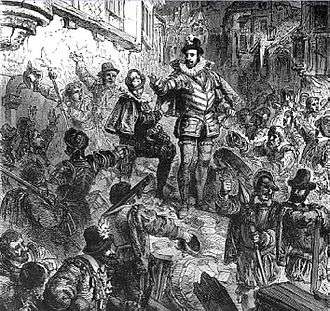
King Henry III at first tried to co-opt the head of the Catholic League and steer it towards a negotiated settlement.[69] This was anathema to the Guise leaders, who wanted to bankrupt the Huguenots and divide their considerable assets with the King. A test of King Henry III's leadership occurred at the meeting of the Estates-General at Blois in December 1576.[69] At the meeting of the Estates-General, there was only one Huguenot delegate present among all of the three estates;[69] the rest of the delegates were Catholics with the Catholic League heavily represented. Accordingly, the Estates-General pressured Henry III into conducting a war against the Huguenots. In response Henry said he would reopen hostilities with the Huguenots but wanted the Estates-General to vote him the funds to carry out the war.[69] Yet, the Third Estate refused to vote for the necessary taxes to fund this war.
The situation degenerated into open warfare even without the King having the necessary funds. Henry of Navarre again sought foreign aid from the German princes and Elizabeth I of England. Meanwhile, the solidly Catholic people of Paris, under the influence of the Committee of Sixteen, were becoming dissatisfied with Henry III and his failure to defeat the Calvinists. On 12 May 1588, the Day of the Barricades, a popular uprising raised barricades on the streets of Paris to defend the Duke of Guise against the alleged hostility of the king, and Henry III fled the city. The Committee of Sixteen took complete control of the government, while the Guise protected the surrounding supply lines. The mediation of Catherine de'Medici led to the Edict of Union, in which the crown accepted almost all the League's demands: reaffirming the Treaty of Nemours, recognizing Cardinal de Bourbon as heir, and making Henry of Guise Lieutenant-General.
The Estates-General of Blois and assassination of Henry of Guise (1588)

Refusing to return to Paris, Henry III called for an Estates-General at Blois in September 1588.[70] During the Estates-General, Henry III suspected that the members of the third estate were being manipulated by the League and became convinced that Guise had encouraged the duke of Savoy's invasion of Saluzzo in October 1588. Viewing the House of Guise as a dangerous threat to the power of the Crown, Henry III decided to strike first. On 23 December 1588, at the Château de Blois, Henry of Guise and his brother, the Cardinal de Guise, were lured into a trap by the King's guards.[71] The Duke arrived in the council chamber where his brother the Cardinal waited. The Duke was told that the King wished to see him in the private room adjoining the royal chambers. There guardsmen seized the duke and stabbed him in the heart, while others arrested the Cardinal who later died on the pikes of his escort. To make sure that no contender for the French throne was free to act against him, the King had the Duke's son imprisoned. The Duke of Guise had been highly popular in France, and the Catholic League declared open war against King Henry III. The Parlement of Paris instituted criminal charges against the King, who now joined forces with his cousin, the Huguenot, Henry of Navarre, to war against the League.
The assassination of Henry III (1589)

It thus fell upon the younger brother of the Duke of Guise, the Duke of Mayenne, to lead the Catholic League. The League presses began printing anti-royalist tracts under a variety of pseudonyms, while the Sorbonne proclaimed on 7 January 1589, that it was just and necessary to depose Henry III, and that any private citizen was morally free to commit regicide.[71] In July 1589, in the royal camp at Saint-Cloud, a Dominican friar named Jacques Clément gained an audience with the King and drove a long knife into his spleen. Clément was killed on the spot, taking with him the information of who, if anyone, had hired him. On his deathbed, Henry III called for Henry of Navarre, and begged him, in the name of statecraft, to become a Catholic, citing the brutal warfare that would ensue if he refused.[72] In keeping with Salic Law, he named Henry as his heir.
Henry IV's "Conquest of the Kingdom" (1589–1593)
The state of affairs in 1589 was that Henry of Navarre, now Henry IV of France, held the south and west, and the Catholic League the north and east. The leadership of the Catholic League had devolved to the Duke de Mayenne, who was appointed Lieutenant-General of the kingdom. He and his troops controlled most of rural Normandy. However, in September 1589, Henry inflicted a severe defeat on the Duke at the Battle of Arques. Henry's army swept through Normandy, taking town after town throughout the winter.
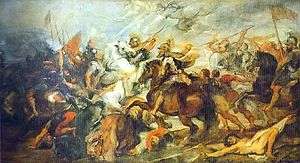
The King knew that he had to take Paris if he stood any chance of ruling all of France. This, however, was no easy task. The Catholic League's presses and supporters continued to spread stories about atrocities committed against Catholic priests and the laity in Protestant England (see Forty Martyrs of England and Wales). The city prepared to fight to the death rather than accept a Calvinist king.
The Battle of Ivry, fought on 14 March 1590, was another decisive victory for Henry against forces led by the Duke of Mayenne. Henry's forces then went on to besiege Paris, but after a long and desperately fought resistance by the Parisians, Henry's siege was lifted by a Spanish army under the command of the Duke of Parma. Then, what had happened at Paris was repeated at Rouen (November 1591 – March 1592).
Parma was subsequently wounded in the hand during the Siege of Caudebec whilst trapped by Henry's army. Having then made a miraculous escape from there, he withdrew into Flanders, but with his health quickly declining, Farnese called his son Ranuccio to command his troops. He was, however, removed from the position of governor by the Spanish court and died in Arras on 3 December. For Henry and the Protestant army at least, Parma was no longer a threat.
War in Brittany
Meanwhile, Philippe Emmanuel, Duke of Mercœur, whom Henry III had made governor of Brittany in 1582, was endeavouring to make himself independent in that province. A leader of the Catholic League, he invoked the hereditary rights of his wife, Marie de Luxembourg, who was a descendant of the dukes of Brittany and heiress of the Blois-Brosse claim to the duchy as well as Duchess of Penthièvre in Brittany, and organized a government at Nantes. Proclaiming his son "prince and duke of Brittany", he allied with Philip II of Spain, who sought to place his own daughter, infanta Isabella Clara Eugenia, on the throne of Brittany. With the aid of the Spanish under Juan del Águila, Mercœur defeated Henry IV's forces under the Duke of Montpensier at the Battle of Craon in 1592, but the royal troops, reinforced by English contingents, soon recovered the advantage; in September 1594, Martin Frobisher and John Norris with eight warships and 4,000 men besieged Fort Crozon near Brest and captured it on November 7, killing 350 Spaniards as only 13 survived.
Toward peace (1593–1598)
Conversion
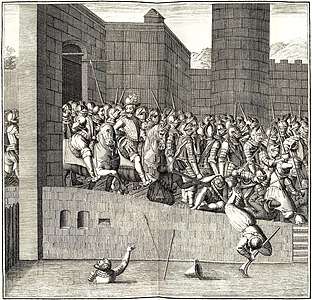

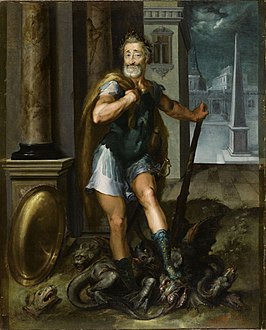
Despite the campaigns between 1590 and 1592, Henry IV was "no closer to capturing Paris".[73] Realising that Henry III had been right and that there was no prospect of a Protestant king succeeding in resolutely Catholic Paris, Henry agreed to convert, reputedly stating "Paris vaut bien une messe" ("Paris is well worth a Mass"). He was formally received into the Catholic Church in 1593, and was crowned at Chartres in 1594 as League members maintained control of the Cathedral of Reims, and, sceptical of Henry's sincerity, continued to oppose him. He was finally received into Paris in March 1594, and 120 League members in the city who refused to submit were banished from the capital.[74] Paris' capitulation encouraged the same of many other towns, while others returned to support the crown after Pope Clement VIII absolved Henry, revoking his excommunication in return for the publishing of the Tridentine Decrees, the restoration of Catholicism in Béarn, and appointing only Catholics to high office.[74] Evidently Henry's conversion worried Protestant nobles, many of whom had, until then, hoped to win not just concessions but a complete reformation of the French Church, and their acceptance of Henry was by no means a foregone conclusion.
War with Spain (1595–1598)
By the end of 1594, certain League members still worked against Henry across the country, but all relied on Spain's support. In January 1595, the king declared war on Spain to show Catholics that Spain was using religion as a cover for an attack on the French state—and to show Protestants that his conversion had not made him a puppet of Spain. Also, he hoped to reconquer large parts of northern France from the Franco-Spanish Catholic forces.[75] The conflict mostly consisted of military action aimed at League members, such as the Battle of Fontaine-Française, though the Spanish launched a concerted offensive in 1595, taking Le Catelet, Doullens and Cambrai (the latter after a fierce bombardment), and in the spring of 1596 capturing Calais by April. Following the Spanish capture of Amiens in March 1597 the French crown laid siege until its surrender in September. With that victory Henry's concerns then turned to the situation in Brittany where he promulgated the Edict of Nantes and sent Bellièvre and Brulart de Sillery to negotiate a peace with Spain. The war was drawn to an official close after the Edict of Nantes, with the Peace of Vervins in May 1598.
Resolution of the War in Brittany (1598–1599)
In early 1598, the king marched against Mercœur in person, and received his submission at Angers on 20 March 1598. Mercœur subsequently went to exile in Hungary. Mercœur's daughter and heiress was married to the Duke of Vendôme, an illegitimate son of Henry IV.
The Edict of Nantes (1598)
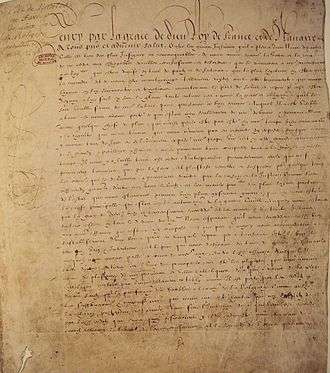
Henry IV was faced with the task of rebuilding a shattered and impoverished kingdom and uniting it under a single authority. Henry and his advisor, the Duke of Sully saw that the essential first step in this was negotiation of the Edict of Nantes—which, rather than being a sign of genuine toleration, was in fact a kind of grudging truce between the religions, with guarantees for both sides.[76] The Edict can be said to mark the end of the Wars of Religion, though its apparent success was not assured at the time of its publication. Indeed, in January 1599, Henry had to visit the Parliament in person to have the Edict passed. Religious tensions continued to affect politics for many years to come, though never to the same degree, and Henry IV faced many attempts on his life; the last succeeding in May 1610.
Aftermath
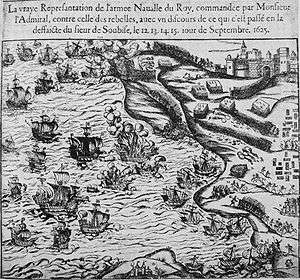
Although the Edict of Nantes concluded the fighting during Henry IV's reign, the political freedoms it granted to the Huguenots (seen by detractors as "a state within the state") became an increasing source of trouble during the 17th century. The damage done to the Huguenots meant a decline from 10% to 8% of the French population.[77] The decision of King Louis XIII to reintroduce Catholicism in a portion of southwestern France prompted a Huguenot revolt. By the Peace of Montpellier in 1622, the fortified Protestant towns were reduced to two: La Rochelle and Montauban. Another war followed, which concluded with the Siege of La Rochelle, in which royal forces led by Cardinal Richelieu blockaded the city for fourteen months. Under the 1629 Peace of La Rochelle, the brevets of the Edict (sections of the treaty that dealt with military and pastoral clauses and were renewable by letters patent) were entirely withdrawn, though Protestants retained their prewar religious freedoms.
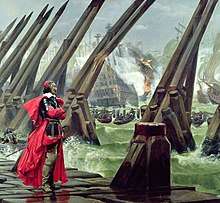
Over the remainder of Louis XIII's reign, and especially during the minority of Louis XIV, the implementation of the Edict varied year by year. In 1661 Louis XIV, who was particularly hostile to the Huguenots, started assuming control of his government and began to disregard some of the provisions of the Edict.[78] In 1681, he instituted the policy of dragonnades, to intimidate Huguenot families to convert to Roman Catholicism or emigrate. Finally, in October 1685, Louis issued the Edict of Fontainebleau, which formally revoked the Edict and made the practice of Protestantism illegal in France. The revocation of the Edict had very damaging results for France.[78] While it did not prompt renewed religious warfare, many Protestants chose to leave France rather than convert, with most moving to the Kingdom of England, Brandenburg-Prussia, the Dutch Republic and Switzerland.
At the dawn of the 18th century, Protestants remained in significant numbers in the remote Cévennes region of the Massif Central. This population, known as the Camisards, revolted against the government in 1702, leading to fighting that continued intermittently until 1715, after which the Camisards were largely left in peace.
Chronology

- 17 January 1562: Edict of Saint-Germain, often called the "Edict of January"
- 1 March 1562: Massacre of Vassy (Wassy)
- March 1562 – March 1563: First War, ended by the Edict of Amboise
- 19 December 1562: Battle of Dreux
- September 1567 – March 1568: Second War, ended by the Peace of Longjumeau
- 10 November 1567: Battle of Saint Denis
- 1568–1570: Third War, ended by the Peace of Saint-Germain-en-Laye
- March 1569: Battle of Jarnac
- June 1569: Battle of La Roche-l'Abeille
- October 1569: Battle of Moncontour
- 1572: St. Bartholomew's Day Massacre
- June 1572: Death of Jeanne d'Albret
- 1572–1573: Fourth War, ended by the Edict of Boulogne
- November 1572 – July 1573: Siege of La Rochelle
- May 1573: Henry d'Anjou elected King of Poland
- 1574: Death of Charles IX
- 1574–1576: Fifth War, ended by the Edict of Beaulieu
- 1576: Formation of the first Catholic League in France
- 1576–1577: Sixth War, ended by the Treaty of Bergerac (also known as the "Edict of Poitiers")
- 1579–1580: Seventh War, ended by the Treaty of Fleix
- June 1584: Death of François, Duke of Anjou, heir presumptive
- December 1584: Treaty of Joinville
- 1587–1598: Eighth War, ended by the Peace of Vervins and the Edict of Nantes
- October 1587: Battle of Coutras, Battle of Vimory
- December 1588: Assassination of the Duke of Guise and his brother
- August 1589: Assassination of Henry III
- September 1589: Battle of Arques
- March 1590: Battle of Ivry, Siege of Paris
- 1593: Henry IV abjures Protestantism
- 1594: Henry IV crowned in Chartres
- June 1595: Battle of Fontaine-Française
- April–September 1597: Siege of Amiens
- April 1598: Edict of Nantes issued by Henry IV
- October 1685: Edict of Fontainebleau issued by Louis XIV
See also
- Edict of toleration
- List of wars and disasters by death toll
- Monarchomachs
- Religion in France
- Virtual Museum of Protestantism
- Siege of Paris (1590)
- Catholic League (French)
- Battle of Craon
References
Footnotes
- Knecht 2002, p. 91.
- Lindberg, Carter (1996). The European Reformations. Oxford: Blackwell. p. 292.
- McGrath, Alister (1995). The Intellectual Origins of the European Reformation. Massachusetts: Blackwell. pp. 39–43.
- McGrath. The Intellectual Origins of the European Reformation. pp. 122–124.
- Spickard, Paul; Cragg, Kevin (2005). A Global History of Christians: How Everyday Believers Experienced Their World. Grand Rapid: Baker. pp. 158–160.
- Lindberg. The European Reformations. p. 275.
- Cairns, Earl (1996). Christianity through the Centuries: A History of the Christian Church (3rd ed.). Grand Rapid: Zondervan. p. 308.
- Grimm, Harold (1973). The Reformation Era 1500–1650 (2nd ed.). New York: Macmillan. p. 54.
- Grimm. The Reformation Era 1500–1650. p. 55.
- Grimm. The Reformation Era 1500–1650. pp. 263–264.
- Cairns, Earl. Christianity through the Centuries. p. 309.
- Lindberg. The European Reformations. p. 279.
- Knecht 1996, p. 2
- Knecht 1996, p. 4.
- Knecht 1996, p. 3.
- Knecht 1996, p. 7.
- Cottret, p. 101.
- Knecht 1996, p. 14.
- Knecht 1996, pp. 16–17.
- Paul Bernstein, Robert W. Green, History of Civilization, Vol.1, (Rowman & Littlefield, 1988), p. 328.
- Holt, p. 20.
- Garnier, Edith, L'Alliance Impie Editions du Felin, 2008, Paris, p. 90.
- Michael Mallett and Christine Shaw, The Italian Wars: 1494–1559, (Pearson Education Limited, 2012), p. 234.
- Audisio, Gabriel, Les Vaudois: Histoire d'une dissidence XIIe – XVIe siecle,, (Fayard, Turin, 1998), pp. 270–271.
- Knecht 1996, p. 6.
- Knecht 1996, pp. 6–7, 86–87.
- Knecht 1996, p. 10.
- Salmon, p. 118.
- France : Renaissance, Religion and Recovery, 1494–1610, Martyn Rady. pp. 52–53. (1998)
- Knecht, p. 195. (2007)
- Knecht 1996, p. 25.
- Salmon, pp.124–125; the cultural context is explored by N.M. Sutherland, "Calvinism and the conspiracy of Amboise", History 47 (1962:111–38).
- Sutherland, N.M. (1984). Princes, Politics and Religion 1547-89. Hambledon Press. p. 64.
- Salmon, p. 125.
- Salmon, pp. 136–137.
- Knecht 1996, p. 27.
- Knecht 1996, p. 29.
- Bryson, David (1999). Queen Jeanne and the Promised Land. p. 111.
- Frieda, Leone (2003). Catherine de Medici: Renaissance Queen of France (First Harper Perennial edition 2006 ed.). Harper Perennial. pp. 132–149.
- See l'Hôpital speech to the Estates General at Orléans of 1560.
- Knecht 1996, pp. 30–31.
- Michel de Castelnau, The Memoirs of the Reigns of Francis I and Charles IX (published in London, 1724 and reproduced by ECCO) p. 110.
- Michel de Castelnau, The Memoirs of the Reigns of Francis II and Charles IX, p. 112.
- Knecht 2000, pp. 78–79.
- Rev. James Fontaine and Ann Maury, Memoirs of a Huguenot Family (New York) 1853.
- Albert Guérard, France: A Modern History, (Ann Arbor, Michigan: University of Michigan Press, 1959), 152.
- Knecht 1996, p. 35.
- Hamilton, Sarah; Spicer, Andrew (2005). Defining the holy : sacred space in medieval and early modern Europe. Aldershot, Hants, England: Ashgate Publishing. ISBN 0754651940. OCLC 60341480.
- Knecht 2000, p. 86.
- Trevor Dupuy, Curt Johnson and David L. Bongard, The Harper Encyclopedia of Military Biography, (Castle Books: Edison, 1992), p. 98.
- Knecht 1996, p. 37.
- Frieda, 268; Sutherland, Ancien Régime, p. 20.
- Knecht 1996, p. 40.
- Jouanna, p. 181.
- Knecht 2000, 151.
- Jouanna, p. 182.
- Jouanna, p. 184.
- Jouanna, pp. 184–185.
- Jouanna, 196.
- Jouanna, p. 199.
- Jouanna, p. 201.
- Lincoln, Bruce, Discourse and the Construction of Society: Comparative Studies of Myth, Ritual, and Classification, Oxford University Press US, P98
- Jouanna, p. 204.
- Jouanna, p. 213.
- Knecht 2000, p. 181.
- Knecht 2000, p. 190.
- Knecht 2000, p. 191.
- Knecht 2000, p. 208.
- Knecht 1996, p. 65.
- Knecht 1996, p. 90.
- Knecht 1996, p. 72.
- Knecht 1996, p. 73.
- Knecht 2000, p. 264.
- Knecht 2000, p. 270.
- Knecht 2000, p. 272.
- Philip Benedict, ‘Un roi, une loi, deux fois: Parameters for the History of Catholic–Protestant Co-existence in France, 1555–1685’, in O. Grell & B. Scribner (eds), Tolerance and Intolerance in the European Reformation (1996), pp. 65–93.
- Hans J. Hillerbrand, Encyclopedia of Protestantism: 4-volume Set, paragraphs "France" and "Huguenots"; Hans J. Hillerbrand, an expert on the subject, in his Encyclopedia of Protestantism: 4-volume Set claims the Huguenot community reached as much as 10% of the French population on the eve of the St. Bartholomew's Day massacre, declining to 8% by the end of the 16th century, and further after heavy persecution began once again with the Revocation of the Edict of Nantes by Louis XIV of France.
- "Edict of Nantes". Encyclopædia Britannica. Retrieved 5 April 2013.
Bibliography
- Acton, John (1906). . . New York: Macmillan. pp. 155–167.
- Baird, H. M. (1889). History of the Rise of the Huguenots of France. 1.
- ——— (1889). History of the Rise of the Huguenots of France. 2. New edition, two volumes, New York, 1907.
- Baird, H. M. (1895). The Huguenots and the Revocation of the Edict of Nantes. C. Scribner's sons.
- Benedict, Philip (1996). "Un roi, une loi, deux fois: Parameters for the History of Catholic-Protestant Co-existence in France, 1555–1685". In Grell, O. & Scribner, B. (eds.). Tolerance and Intolerance in the European Reformation. New York: Cambridge University Press. pp. 65–93. ISBN 0-521-49694-2.
- Di Bondeno, Agostino (2018). Colloqui di Poissy. Rome: Albatros. ISBN 978-8-85679319-2.
- Castelnau, Michel de, The Memoirs of the Reigns of Francis II and Charles IX (published in London in 1724 and reprinted by ECCO.)
- Cottret, Bernard (2000) [1995], Calvin: Biographie [Calvin: A Biography] (in French), Translated by M. Wallace McDonald, Grand Rapids, Michigan: Wm. B. Eerdmans, ISBN 0-8028-3159-1
- De Caprariis, Vittorio (1959). Propaganda e pensiero politico in Francia durante le guerre di religione (1559–1572). Napoli: Società Editrice Italiana.
- Diefendorf, Barbara B. (1991). Beneath the Cross: Catholics and Huguenots in Sixteenth-Century Paris. Oxford: Oxford University Press. ISBN 0-19-506554-9.
- Davis, Natalie Zemon (1975). Society and Culture in Early Modern France. Stanford: Stanford University Press. ISBN 0-8047-0868-1.
- Frieda, Leonie (2005). Catherine de Medici. London: Phoenix. ISBN 978-0-06-074492-2.
- Greengrass, Mark (1986). France in the Age of Henry IV. London: Longman. ISBN 0-582-49251-3.
- ——— (1987). The French Reformation. London: Blackwell. ISBN 0-631-14516-8.
- ——— (2007). Governing Passions: Peace and Reform in the French Kingdom, 1576–1585. Oxford: Oxford University Press. ISBN 978-0-19-921490-7.
- Guérard, Albert, France: A Modern History (Ann Arbor, Michigan: University of Michigan Press, 1959).
- Holt, Mack P. (2005). The French wars of religion, 1562–1629. Cambridge. ISBN 0-521-83872-X.
- Hulme, E. M. (1914). The Renaissance, the Protestant Revolution, and the Catholic Reaction in Continental Europe. New York.
- Jouanna, Arlette; Boucher, Jacqueline; Biloghi, Dominique; Thiec, Guy (1998). Histoire et dictionnaire des Guerres de religion. Collection: Bouquins (in French). Paris: Laffont. ISBN 2-221-07425-4.
- Knecht, Robert J. (1996). The French Wars of Religion 1559–1598. Seminar Studies in History (2nd ed.). New York: Longman. ISBN 0-582-28533-X.
- ——— (2000). The French Civil Wars. Modern Wars in Perspective. New York: Longman. ISBN 0-582-09549-2.
- ——— (2001). The Rise and Fall of Renaissance France 1483–1610. Oxford: Blackwell. ISBN 0-631-22729-6.
- ——— (2002). The French Religious Wars 1562–1598. Osprey Publishing. ISBN 9781841763958.
- ——— (2007). The Valois: Kings of France 1328–1589 (2nd ed.). New York: Hambledon Continuum. ISBN 978-1-85285-522-2.
- Lindsay, T. M. (1906). A History of the Reformation. 1. T and T Clark.
- ——— (1907). A History of the Reformation. 2.
- Salmon, J. H. M. (1975). Society in Crisis: France in the Sixteenth Century. London: Methuen. ISBN 0-416-73050-7.
- Pearson, Hesketh, Henry of Navarre: The King Who Dared (New York: Harper & Rowe, Publishers, 1963).
- Sutherland, N. M. (1962). "Calvinism and the conspiracy of Amboise". History. 47 (160): 111–138. doi:10.1111/j.1468-229X.1962.tb01083.x.
- Sutherland, N. M. Catherine de Medici and the Ancien Régime. London: Historical Association, 1966. OCLC 1018933.
- Thompson, J. W. (1909). The Wars of Religion in France, 1559–1576. Chicago: Chicago, The University of Chicago Press; [etc., etc.
- Tilley, Arthur Augustus (1919). The French wars of religion.
Historiography
- Diefendorf, Barbara B. (2010). The Reformation and Wars of Religion in France: Oxford Bibliographies Online Research Guide. Oxford U.P. ISBN 9780199809295.
- Frisch, Andrea Forgetting Differences: Tragedy, Historiography, and the French Wars of Religion (Edinburgh University Press, 2015). x + 176 pp. full text online' online review
- Christian Mühling: Die europäische Debatte über den Religionskrieg (1679–1714). Konfessionelle Memoria und internationale Politik im Zeitalter Ludwigs XIV. (Veröffentlichungen des Instituts für Europäische Geschichte Mainz, 250) Göttingen, Vandenhoeck&Ruprecht, ISBN 9783525310540, 2018.
Primary sources
- Potter, David L. (1997). French Wars of Religion, Selected Documents. Palgrave Macmillan. ISBN 9780312175450.
- Salmon, J.H.M., ed. French Wars of Religion, The How Important Were Religious Factors? (1967) short excerpts from primary and secondary sources
External links
| Wikimedia Commons has media related to French Wars of Religion. |
- The Wars of Religion, Part I
- The Wars of Religion, Part II
- French Religious Wars
- The Wars of Religion
- The eight wars of religion (1562–1598) in The Virtual Museum of Protestantism

